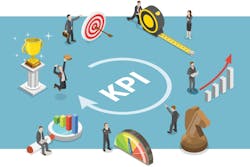Effective labor rate is not controlled by how much you charge, but how much you produce. It’s a simple calculation (total labor sales divided by total labor hours billed) that tells you what your shop actually makes per billed hour.
Anything you can do to increase the efficiency of your techs is going to increase your effective labor rate, says Reilly, owner of Same Day Auto Service in Clackamas, Ore. It doesn’t change what your customer’s being charged, but it changes your bottom line.
Reilly says he has an effective labor rate over 100 percent in his shop, which has mainly been achieved by decreasing his technician’s downtime, and working to speed up customer authorization of repairs, rather than simply charging more. As a consultant for Elite, Reilly has instructed dozens of shop owners on how they can increase their effective labor rate solely by making their operations more efficient. Very few shops are able to pass the 100 percent effective labor rate threshold, so he tries to get his clients to 100 percent.
Here are Reilly’s keys to maximizing this vital KPI.
The first thing I’ve found with my clients is that technicians spend a lot of time standing around waiting for parts, waiting for shop supplies, nuts, bolts, etc., or waiting for authorization. All those time wasters reduce your effective labor rate. So, one of the first things I look at is, is the shop printing the estimate before the customer arrives? I recommend that the estimate gets printed when the customer makes the appointment.
Let’s say the customer calls Monday, and makes an appointment for Wednesday. That goes into a folder with Monday through Friday tabs. The day before the appointment, the estimate is prepared, and the service advisor has to look at the history of the vehicle, and try to ascertain what other services may be needed. Then when the customer comes in, they’re ready to present the whole sales package.
Having adequate shop supplies is crucial to increasing your effective labor rate. Let’s say the customer is coming in because their alternator, or battery light is on. We know that, 90 percent of the time, it’s going to need an alternator. So we’re going to order the alternator the night before, so we don’t have a technician standing around when he needs it.
A lot of shops tend to be skimpy on some of these shop supplies. I’ve seen techs huddle around big bins of used old nuts and bolts and spend 15–20 minutes trying to find what they’re missing. That’s decreasing your effective labor rate, because it’s not something for which you can bill the customer. An investment in adequate shop supplies, like nuts and bolts, is crucial to increasing your effective labor rate.
When a customer makes a call, you can pre-sell testing and repair in a ballpark figure. This enables a technician to continue working without having to wait for authorization. If the customer says he or she has a check engine light, you can say the testing costs X dollars and typically we find check engine lights are $300–$700 to repair. You can ask if he or she wants to go ahead if it’s under $700, or if it’s better for the shop to call him or her first. Probably more than half your customers will say that’s fine. The tech then knows that if he or she finds something that will cost $500, he or she can keep going, and doesn’t have to stop.
A lot of my clients will ask a customer for a phone number, and the customer will often give them a number they can’t reach all day long. After the customer gives you the number the first time, you should ask if this is the number he or she will be at all day. Some shops have gone to texting, because they find that some customers are more available through that medium.

